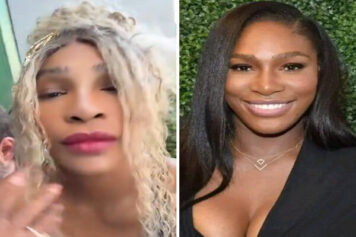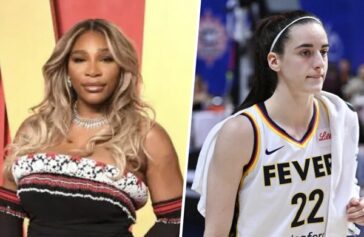They call her the ‘ Serena Slayer.’ Or at least they did, up until 19-year-old American tennis up-and-comer Sloane Stephens’ Australian Open hopes were dashed by Victoria Azarenka in Thursday’s semifinals. But the deafening references to baton-passing and guard-changing in the discussion following Stephens’ victory over Serena Williams in the quarterfinals have not gone completely silent, largely because Stephens, like Williams, is also black and the tennis landscape is still so white that any speck of melanin is more mountain than molehill. That the slayer of Serena is black can be read in two ways. The old guard Serena-haters might see it as an unfortunate happenstance, dampening the exuberant glow that might follow the triumph of a willowy blonde tossing her hair on the road to victory against the fire-breathing dragon who’s taken up residence in the castle. But there is also the option to use Stephens’ race to squeeze a greater helping of the stuff of legend from the story, as if the only way to kill a mythological creature of mythological strength and prowess is with another mythological creature of as-yet unproven strength and prowess, but much-heralded and deserved anticipation of greatness. Add luck (or in this case, injury) and stir. And yes, exceptional black people are mythological creatures.
The blackness of the Williams sisters, and indeed their entire family, is profound because its scope goes far beyond that which is generally accepted for the kind of fame they have achieved. Interviewing Venus for an article that should have been about the sisters’ declining careers (Serena’s prompt win at Wimbledon and both sisters’ wins at the 2012 Olympics skewered that intent), John Jeremiah Sullivan of The New York Times remarked on Venus’ accent, which inherited a trace of their father’s Louisiana drawl. This is notable because it is a glaring reminder of the Williams family connection to the ugly, swept-under-the-rug southern origin of American blackness and it is as important to the way they are received as Barack Hussein Obama’s glaring lack of the same is to the way he is.
As Richard Williams has explained, he raised his girls in the 1980’s to have the resolve and stamina of 1940s and 50s black Americans, so when racism rears its ugly head on and off the court, it is acknowledged and understood, not internalized with the power of distraction. This is the same kind of imperviousness that used to hang in the air whenever Michael Jackson got into trouble and called on the Nation of Islam to fill out his entourage. So Serena must be slayed because, as Sullivan points out, she was born into a black family with the organizing competence of a military regiment, “in order to lay siege” to the white-as-snow world of tennis. There is a warlike, violent element in the language that swirls around the sisters, which you do find in a lot of sport-speak, but, in this case, it is amplified by the violence inherent in the legacy of race-consciousness in America. And this tension, it seems, can only be released by a constant stream of criticism recently leveled mainly at Serena, that has nothing whatsoever to do with the sport of tennis, and everything to do with the sport of good old, down home American racism.
This of course means abounding controversy, leaving no stone unturned: speculation over extensive plastic surgery; Serena’s occasional back-talking (to umpires no less); her emotive grunting in play; C-walking at the Olympics; the overwhelmingly intense, derisive focus on her body (including how she uses and/or abuses it, what it can and cannot do, how/where/when/in what condition it is seen). Taken in that order, I’d say that nose-work on black female celebrities is a subject worthy of an entire piece all on its own, and anyone who focuses on that with regard specifically to Serena is tripping if they think her nose is the most undesirably African thing about her. Furthermore, the idea that an athlete would do something as stupid as to purposely damage her gluteal muscles is pretty ridiculous. Back-talking in tennis? Has anyone ever met a fellow named John McEnroe? As for the grunting, according to The Daily Beast, Serena is only the fifth loudest female grunter on the tour.
When it comes to the celebratory Crip-walking at the Olympics – on Centre Court at Wimbledon, no less…man did that make me smile. Admittedly, there are many who didn’t, and a few of them had sort of good reasons – gang culture, glorifying violence, etc. – but I’m generally opposed to attaching such heavy burdens to dance steps. She’s from Compton. It’s not that easy of a dance to do right, and she had just won Olympic gold. And it’s a dance. Would people have been upset if she broke down a righteous capoeira ginga? Because you actually can use that style of dance to kill someone. For me, the Olympian C-walk of 2012 was the sports equivalent of rocking cornrows to the White House.
The most troubling in the controversy shortlist is the construction of Serena Williams’ body as a site for all kinds of intellectual and quasi- and/or pseudo-intellectual labor. Of course, there is a manner in which the bodies of all athletes are configured for public consumption. Along with this comes the dissolution of social protocol that makes it impolite to discuss weight gain or loss, agility, and, to some extent, shape and beauty. But there is also a manner in which the bodies of black women are configured for consumption, although here there sometimes emerges a veil intended to conceal the extent to which this is true. Hiding the history of how black women’s bodies nurtured and bore the pain of the birth of this country helps to shield the kinds of people who start whining about race cards whenever anyone points out racist language and behavior when pointed at a black woman, no matter how glaringly obvious.
This danger, of being named a race baiter or reverse racist, helps keep the outrage in check. We got good and mad when Caroline Wozniacki stuffed her sports bra and panties with towels and pranced around the court imitating Serena during an exhibition game, but it gets oddly quiet when someone points out not only that this wasn’t her first time doing it, but also that she wasn’t the first one to do it. We say, as Jewel Woods did, that coded criticism of Serena’s “weight and fitness” represents a metaphor for the Venus Hottentot’s “buttocks and breasts,” but we stop short of saying what is really going on and laying it out plain.
Which is: Serena Williams is not a metaphor for the Venus Hottentot; she is the 21st century, living, breathing, world-traveling exhibition of black female-ness, designed to simultaneously titillate and disgust, bearing down and giving birth to caricatures of her own self and her own legacy, which all are welcomed to purchase, steal, sell, give away, or toss into the nearest trash heap with no regard whatsoever.
Williams family matriarch Oracene recently said of her daughters: “you have these these two old, black girls, up in age now, and they’re still holding up America.” The perfection underneath this statement helps to illuminate an element to the race question in the Williams’ legacy that is too often overlooked. Of course, the scrutiny comes because they are famous, and they are famous because they are phenomenal, but the style of the scrutiny is, at its heart, sadly, run-of-the-mill. They are black women in America, first. They were little black girls with braids, then they were teenagers with braids, then they were young women with, at times, frighteningly colorful and precariously woven weaves, now they are women with wildly ‘natural’ manes.
The comparison between Don Imus’ labeling of the Rutgers women’s basketball team as “nappy-headed hoes” and the media reception of the Williams’ sisters is often attributed to the fact that all the women in question are athletes, when the issue is really that all the athletes are black women. Meaning, a black woman in America is a black woman in America, and to the bigoted, confused, prejudiced, racist, ignorant fools – Imus among them – we are all the same. And, to some, we are all nappy-headed hoes, no matter what chemicals or processed locks we subdue our naps with. In their eyes, Oprah is a nappy-headed ho. Beyonce is a nappy-headed ho. Michelle Obama, Kerry Washington, Condoleeza Rice, Whoopie Goldberg, Melissa Harris-Perry and now, Sloane Stevens, are all nappy-headed hoes, although they have more money and fame than most.
Shane Roberts begins a piece on the Wozniacki affair with the following: “People love Serena Williams’ body, white people in particular.” When I read that sentence, I swung my head around both ways, looking for a candid cam or a glimpse of a furtive hacker fleeing the scene of the laptop cafe. I should mention that this was after I had already gotten lost in the comments section of several articles debating the claims that Williams’ assets were surgically enhanced, and discovered that not only do people think she is ugly, but people think she’s part man, part gorilla, and devastatingly hideous. And after that, I read another article that claimed that Serena’s “extraordinarily beautiful face” is the reason that the animalization of her body doesn’t fly in the way that it does for other athletes. I knew that people were fascinated, maybe obsessed, likely infatuated with her body, but unequivocal, unabashed, four-letter, L-O-V-E love? If you are scratching your head right now, we are scratching together.
Then again, who doesn’t love a nappy-headed ho? Isn’t that really what’s behind the hopeful whisper that found voice in Sloane Stephens’ win? Serena may not be over, but she’s inching toward that finish line, and when she C-walks her brazenly bountiful body over it, it’s not just her game we will miss. Even if Stephens is able to come anywhere near Serena’s athleticism, let’s face it…her first name is Sloane. And along with that comes a story, not of ducking bullets on the tennis court in the neighborhood, but of crossing the street to play at the neighborhood country club. We don’t have a clue how Stephens will deal with the fine-toothed combing of her parts, but we do know that Williams’ parts have inspired a downpour of sociocultural engagement, unseen since the Hottentot (and maybe Josephine Baker, who, like Serena, also made a home in Paris). Sure, we’re excited to see the coronation of the next sable-skinned tennis royal, but deep down we know that crown was custom made for our one and only. Long live the queen.



